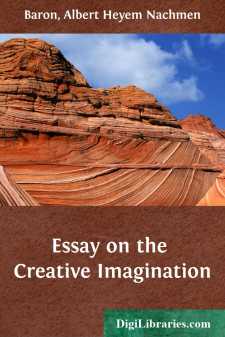Categories
- Antiques & Collectibles 13
- Architecture 36
- Art 48
- Bibles 22
- Biography & Autobiography 813
- Body, Mind & Spirit 142
- Business & Economics 28
- Children's Books 14
- Children's Fiction 11
- Computers 4
- Cooking 94
- Crafts & Hobbies 4
- Drama 346
- Education 46
- Family & Relationships 57
- Fiction 11828
- Games 19
- Gardening 17
- Health & Fitness 34
- History 1377
- House & Home 1
- Humor 147
- Juvenile Fiction 1873
- Juvenile Nonfiction 202
- Language Arts & Disciplines 88
- Law 16
- Literary Collections 686
- Literary Criticism 179
- Mathematics 13
- Medical 41
- Music 40
- Nature 179
- Non-Classifiable 1768
- Performing Arts 7
- Periodicals 1453
- Philosophy 64
- Photography 2
- Poetry 896
- Political Science 203
- Psychology 42
- Reference 154
- Religion 513
- Science 126
- Self-Help 84
- Social Science 81
- Sports & Recreation 34
- Study Aids 3
- Technology & Engineering 59
- Transportation 23
- Travel 463
- True Crime 29
Essay on the Creative Imagination
Categories:
Description:
Excerpt
AUTHOR'S PREFACE
Contemporary psychology has studied the purely reproductive imagination with great eagerness and success. The works on the different image-groups—visual, auditory, tactile, motor—are known to everyone, and form a collection of inquiries solidly based on subjective and objective observation, on pathological facts and laboratory experiments. The study of the creative or constructive imagination, on the other hand, has been almost entirely neglected. It would be easy to show that the best, most complete, and most recent treatises on psychology devote to it scarcely a page or two; often, indeed, do not even mention it. A few articles, a few brief, scarce monographs, make up the sum of the past twenty-five years' work on the subject. The subject does not, however, at all deserve this indifferent or contemptuous attitude. Its importance is unquestionable, and even though the study of the creative imagination has hitherto remained almost inaccessible to experimentation strictly so-called, there are yet other objective processes that permit of our approaching it with some likelihood of success, and of continuing the work of former psychologists, but with methods better adapted to the requirements of contemporary thought.
The present work is offered to the reader as an essay or first attempt only. It is not our intention here to undertake a complete monograph that would require a thick volume, but only to seek the underlying conditions of the creative imagination, showing that it has its beginning and principal source in the natural tendency of images to become objectified (or, more simply, in the motor elements inherent in the image), and then following it in its development under its manifold forms, whatever they may be. For I cannot but maintain that, at present, the psychology of the imagination is concerned almost wholly with its part in esthetic creation and in the sciences. We scarcely get beyond that; its other manifestations have been occasionally mentioned—never investigated. Yet invention in the fine arts and in the sciences is only a special case, and possibly not the principal one. We hope to show that in practical life, in mechanical, military, industrial, and commercial inventions, in religious, social, and political institutions, the human mind has expended and made permanent as much imagination as in all other fields.
The constructive imagination is a faculty that in the course of ages has undergone a reduction—or at least, some profound changes. So, for reasons indicated later on, the mythic activity has been taken in this work as the central point of our topic, as the primitive and typical form out of which the greater number of the others have arisen. The creative power is there shown entirely unconfined, freed from all hindrance, careless of the possible and the impossible; in a pure state, unadulterated by the opposing influence of imitation, of ratiocination, of the knowledge of natural laws and their uniformity.
In the first or analytical part, we shall try to resolve the constructive imagination into its constitutive factors, and study each of them singly....


